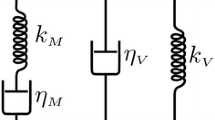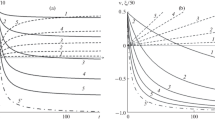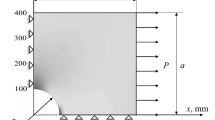Conclusions
We have constructed a unidimensional creep model which describes all characteristic stages of the process and considers cyclicity of loading. The base creep experiment can be limited to the steady-state stage and does not entail determination of a damage function.
It was shown that the character of creep can be determined from the type of instantaneous strain curve. It was established in particular that only transient creep will occur for media which exhibit linear strain-hardening, all stages will be realized in media exhibiting exponential strain-hardening, and an ideally plastic medium will behave over time as a linearly viscous medium.
Creep is accelerated in media in which a cyclic load reduces the ductility indices. If strain-hardening occurs, then a cyclic load retards creep.
Similar content being viewed by others
Literature Cited
J. Boyle and J. Spense, Analysis of Stresses in Structures during Creep [Russian translation], Mir, Moscow (1986).
V. P. Golub, A. S. Oleinik, and V. N. Pavlov, “Evaluating the tension curves of heat-resistant metallic materials,” Probl. Prochn., No. 7, 31–35 (1987).
S. A. Shesterikov (ed.), Laws of Creep and Rupture Strength: Handbook [in Russian], Mashinostroenie, Moscow (1983).
Yu. I. Kadashevich, E. L. Kirina, and V. S. Kleev, “An interpretation of the theory of plastic heredity,” in: Theoretical-Experimental Method of Investigating Creep in Structures: Collection of Scientific Transactions, Kuibyshev Polytechnic Institute, Kuibyshev (1984), pp. 190–193.
Yu. N. Rabotnov, Creep of Structural Elements [in Russian], Nauka, Moscow (1966).
Yu. N. Rabotnov and S. T. Mileiko, Short-Term Creep [in Russian], Nauka, Moscow (1970).
Yu. V. Suvorova, “Criterion of the plastic deformation of metals with different loading regimes,” Izv. Akad. Nauk SSSR, Mekh, Tverd., Tela, No. 1, 73–79 (1984).
Yu. N. Shevchenko and R. G. Terekhov, Physical Equations of Thermoviscoplasticity [in Russian], Naukova Dumka Kiev (1982).
S. A. Shesterikov and A. M. Lokoshchenko, “Creep and rupture strength of metals,” Itogi Nauki Tekh. Mekh. Deform. Tverd. Tela,13, 3–104 (1980).
Additional information
Institute of Mechanics, Academy of Sciences of the Ukrainian SSR, Kiev. Translated from Prikladnaya Mekhanika, Vol. 24, No. 12, pp. 71–79, December, 1988.
Rights and permissions
About this article
Cite this article
Golub, V.P., Oleinik, A.S. Modeling unidimensional creep by the method of isochrones. Soviet Applied Mechanics 24, 1204–1211 (1988). https://doi.org/10.1007/BF00887928
Received:
Issue Date:
DOI: https://doi.org/10.1007/BF00887928




